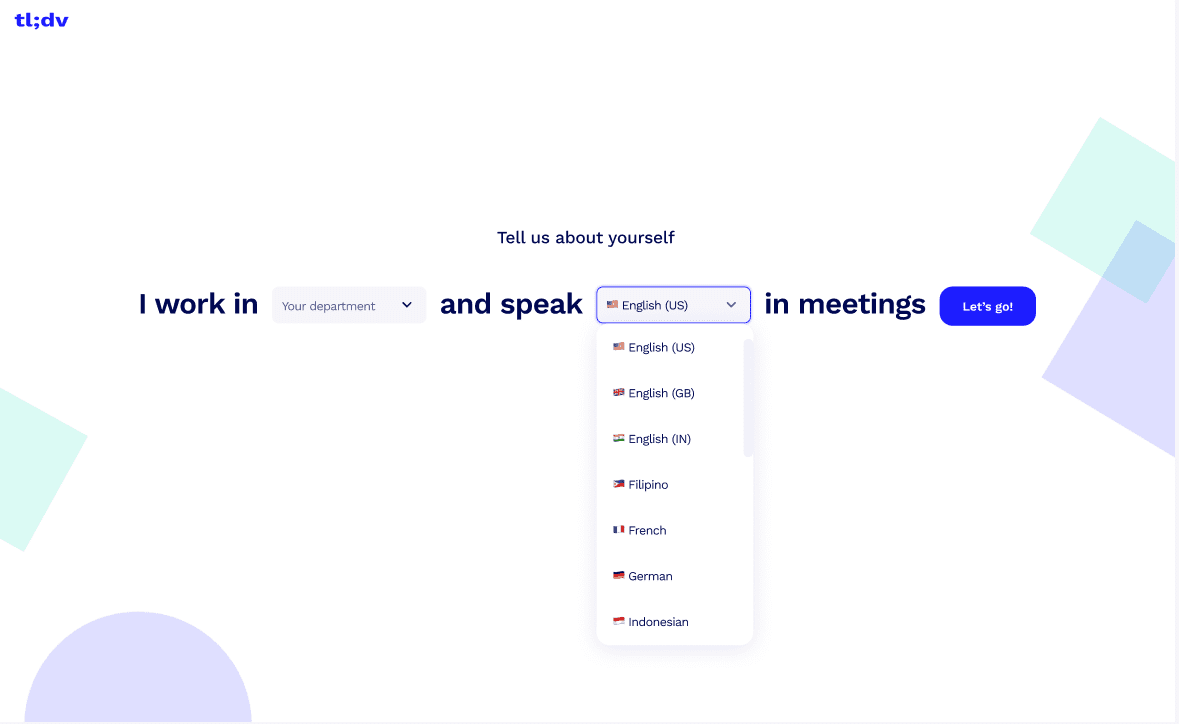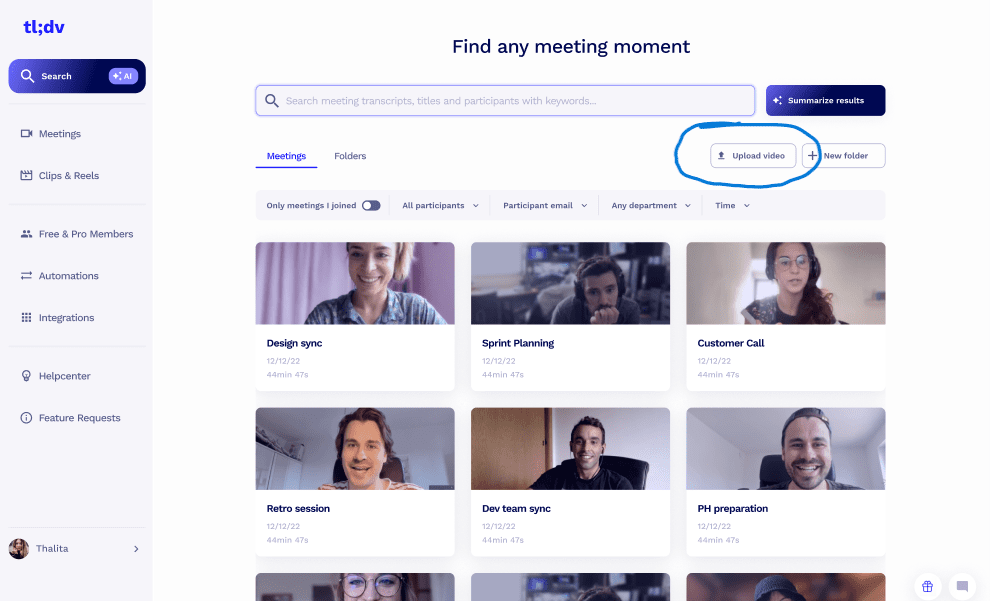Transcribing MPEG to text doesn’t have to be a bore. In fact, it’s waaaaay easier than you might think. Super quick, too. I’d wager you can transcribe your first MPEG file to text within 10 minutes of reading this article. Any additional files will be even quicker: guaranteed.
How can I make such a bold claim? Because when you use tl;dv, you get a free robot to do the work for you at ten times the speed. I’m not joking.
Advancements in AI have led us to turbo speed when it comes to technology. So if you have an MPEG file you want to transcribe to text, or even an MKV, MP4, or WAV file, then tl;dv is the way to go.

How to Transcribe MPEG to Text
GPT has seen a meteoric rise and, unless you’ve been living under a rock, you’re bound to have heard of it. And why is that relevant? tl;dv’s AI is powered by GPT, meaning it piggybacks off the overwhelming success of the open source AI project. It’s been tweaked and optimized so that it can accurately transcribe MPEG files, among others, as well as live meetings. It can even detect speakers, while many of its competitors can’t.
So, you want to transcribe MPEG to text with a 90% accuracy rate for free? tl;dv is your answer. You can get even higher accuracy rates if you go with a manual transcription from a professional, but unless the transcript is super important (like super duper important) then it’s just a waste of time and money.
Before we get onto the easy five-step guide to transcribing your files, what actually are MPEGs?
What are MPEG Files?
MPEG, short for Moving Picture Experts Group, is a family of video and audio compression standards developed by the MPEG working group. MPEG standards are widely used for encoding and decoding digital video and audio data. It’s often used to share videos over the internet.
The MPEG standards aim to achieve efficient compression while maintaining high-quality video and audio playback. The standards define various compression techniques and algorithms that enable the reduction of file sizes without significant loss of quality.
The most notable MPEG standards include:
MPEG-1: Developed in the early 1990s, this standard is commonly used for video CDs (VCDs) and early digital video formats. MPEG-1 can compress video and audio data at moderate quality levels.
MPEG-2: This standard was introduced in the late 1990s and is widely used for digital television broadcasting, DVDs, and some video streaming services. MPEG-2 provides higher video quality and supports interlaced video.
MPEG-4: This standard, introduced in the early 2000s, provides advanced compression techniques and is widely used for various purposes, including video streaming, video conferencing, and multimedia content delivery over the internet. MPEG-4 includes features for interactive multimedia, object-oriented coding, and support for a wide range of devices.
It’s worth mentioning that files utilizing the MPEG-4 compression techniques are often saved as .MP4 files instead. We also have a detailed guide for transcribing MP4 to text.
MPEG files may also use the .MPG extension. Double check your files before using tl;dv.
Which File Types Does tl;dv Transcribe?
tl;dv transcribes more than just MPEG files. See below for a full list of files you can transcribe quickly and easily with tl;dv’s top of the range AI:
- MOV
- MKV
- MP4
- WAV
- MPEG
This is perfect if you have dozens of different files from different sources that you need transcripts for. You can transcribe MOV to text one day, MKV to text the next day, and the method is the same.
But wait a second, what exactly is tl;dv?
What is tl;dv?
tl;dv is your new best friend. With its capacity to transcribe your pre-recorded files, but also live meetings, tl;dv is a blistering new display of AI technology. It showcases what was merely sci-fi ten years ago: fast, accurate, and easy transcriptions. Oh, and it’s FREE!
tl;dv records, transcribes, and translates video calls in more than 25 languages. By integrating with the superpower that is GPT, tl;dv is able to make your most complex task easy. In this case: transcripts. Got an MPEG file that you need text for? tl;dv eats them for breakfast and unapologetically burps out your transcript. You’ll get used to it.
When recording meetings, tl;dv can do this in real-time. If you thought you were watching a robot juggling fiery knives, you’re about to see it get on a unicycle. tl;dv will bend over backwards to make your life easier. At the end of your meeting, you’ll get an automatic summary that highlights the key moments and action points, as well as the full transcript delivered instantly to your email, and that of all the meeting participants.
What makes this even better is that, unlike most of its competitors, tl;dv has a super accurate speaker recognition feature that allows it to detect speakers, even in lower quality audios!
But if you thought tl;dv was just a walking, talking transcription machine, you were wrong. It can help you create highlights, reels, and clips from your videos by allowing you to directly edit the transcript. Highlight the parts you want to keep and cut the rest. This makes videos ridiculously easy to skim over. Might seem like an irrelevant feature until you realize the amount of time it will save when it comes to UX research, product development, and even recruiting new employees. tl;dv is single-handedly revolutionizing an entire industry!
To enhance this feature even more, tl;dv empowers you to create timestamps so you can tag your friends or colleagues at the exact moment that’s relevant to them and they’ll receive a link directly to their email. This reduces unnecessary time spent in meetings because your teammates can just catch up with the parts that are important to them in their own time. The world has seen enough online meetings.
“On average, companies invest more than $80,000 in meetings per employee, every year.” Who knew they could’ve been using tl;dv instead…
So, are you ready to transcribe your MPEG to text? Here’s how to do it.
Step-by-Step Guide for Transcribing MPEG to Text
Get ready to transcribe your audio to text. If you follow along with these five simple steps, you’ll have your transcript in no time. We’ve provided screenshots so that you can do it at the same time!
1. Set up an account over at tldv.io. It takes just a few moments.
2. Pick your language.

tl;dv offers more than 25 languages to choose from, including:
- English
- German
- Dutch
- Japanese
- Korean
- Spanish
- Portuguese
- Polish
- Italian
- French
3. Click “Upload video”.

4. Select the MPEG file that you’d like to transcribe and wait until it’s processed. This depends on the file size, but is usually very quick.

5. Receive your MPEG transcript in addition to an automated summary of the video.
And Bob’s your uncle. Easy, right? Don’t forget: the first two steps only need to be completed once. On your second file transcript, you simply upload the file and wait. Fast, easy, free. What more could you want?
Transcribe Your MPEG File Today!
You’ve got nothing to lose. With a completely free, five-minute-max set-up, and the ability to transcribe MPEG, MKV, MP4, MOV, and WAV, tl;dv is your must-have transcription tool.
If you’re looking to transcribe in a professional capacity, check out tl;dv’s paid plans. Their Business and Enterprise plans integrate with all the best work platforms and CRM softwares (including Salesforce, Hubspot, Notion, and Slack). They also have a wide array of other useful features.
If, however, you’re just transcribing on a personal level, make the most of the free plan! It offers unlimited recording and transcription minutes (during live meetings) as well as state-of-the-art AI services. Download it for Zoom or Google Meet.





